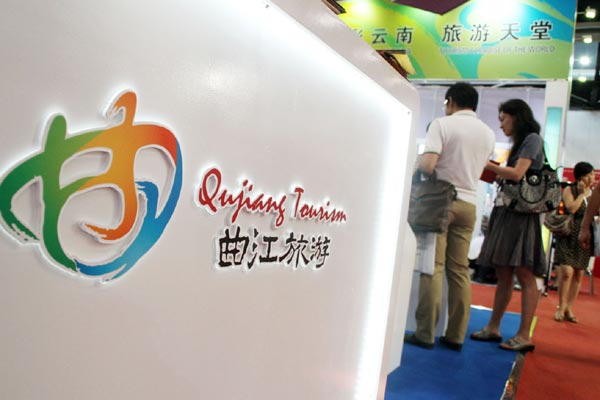|
 |
|
?Tourism in Qujiang advertised in Xi'an, Shaanxi province. Located in southeastern Xi'an, Qujiang was the royal garden of the Tang Dynasty. [Photo/China Daily] |
'Belt and Road' scenic destinations to cash in on high-speed rail
Travel agencies in Xining, Qinghai province, have seen their business boom ahead of the upcoming May Day holiday thanks to the opening of a high-speed railway, as part of the "Belt and Road Initiative".
The high-speed railway, unveiled earlier this year, aims to eventually enhance regional connectivity throughout Asia and Europe.
The "Belt and Road Initiative", namely, the Silk Road Economic Belt and the 21st Century Maritime Silk Road, were put forward by President Xi Jinping during his visits to Kazakhstan in September, 2013.
The new railway starts in Xining, Qinghai province and terminates in Urumqi, capital of the Xinjiang Uygur autonomous region. It passes near a number of major tourism attractions on the ancient Silk Road and cuts the traveling time between the two cities by seven hours.
Zhang Xiaoling, manager of Jiayuguan Chengxin Holiday Travel Agency in Lanzhou, Gansu province, said that about a month away from the May Day holiday, her company had already received orders and inquiries about the trip, and expects many more to come.
The initiative is also greatly benefiting outbound and inbound tourism and tourism agencies' online and offline businesses, said industry experts.
Ctrip.com, the largest online travel agency in China, has seen sales of its products along the Silk Road more than double since the opening the highspeed rail route in January, according to Chen Ying, from the public relations department at Ctrip. The agency has designed more than 20 routes along the Silk Road destinations for the upcoming peak season between May and October.
The agency has also developed more than a dozen of routes and tours based on the Maritime Silk Road, which covers major ports in the country including Nanjing, Yangzhou, Lianyungang, Suzhou, Quanzhou, Guangzhou and Ningbo.
The Maritime Silk Road began about 1,000 years ago when merchants sailed from China's eastern and southern coasts to Southeast Asia, South Asia, East Africa, the Persian Gulf and the Red Sea, carrying Chinese goods such as silk, ceramics, lacquerware, tea, medicines and cotton garments. In return, pearls, turtle shells, spices and other exotic treasures were introduced to China via the trade route.
The signature discovery on the Maritime Silk Road, the Nanhai No 1 shipwreck from the Song Dynasty (960-1279), which led to the discovery of around 200 porcelain pieces, is also a popular destination for Chinese tourists, according to Ctrip.
Dai Bin, head of the China Tourism Academy, said the Belt and Road Initiative will greatly improve infrastructure facilities along the routes, bringing convenience to travelers across provinces and regions.
Dai said the implementation of the initiative will help the world know more about China, and more places in the country will become global tourism destinations
Meanwhile, the Middle East and the Central Asia, which remain mostly untapped for Chinese travelers, are expected to be further explored by Chinese travelers.
According to the academy, by 2020, the initiative is expected to boost outbound tourism spending to 200 billion yuan ($32.26 billion) and inbound traveling spending to 120 billion yuan.
Wang Wen and Xue Chaohua contributed to the story.
